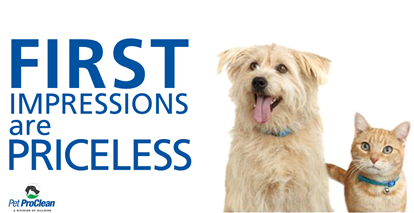
Just about every client experience expert talks about the importance of the first impression.
What are your clients seeing, smelling and feeling when they walk in the door of your hospital? What are they seeing and smelling outside of your hospital before they even walk in the door?
What is their impression of your exam rooms, where they spend idle time waiting?
In a survey of pet owners, over 60% said that the cleanliness of the front lobby and exam rooms was a factor in their satisfaction with their veterinarian. 20% of pet owners responded that lack of cleanliness is a reason that they decided to change animal hospitals.
Let’s take a look at what some authors who write about customer service have to say about cleanliness:
In his book, 101 Secrets of a High-Performance Veterinary Practice, Bob Levoy writes, “Cleanliness makes a difference. It can make an important difference between practices. It is a message to the client about the quality of care we provide.”
Carl Sewell, author of Customers for Life says that he aims to make the grounds of his stores look like Disneyland because, “We are setting the tone for the product we are selling. And we are setting a tone for the people who work here. Customers judge us on just about everything.
Why would you ever want to give somebody a reason-even a subconscious reason-to question doing business with you?”
Dennis McCurnin, in his book, Veterinary Practice Management, writes, “In a competitive market…….Building maintenance and care of the grounds, plantings and parking areas are clear signals to clients about the quality of service to be found inside the facility... A practice or facility does not have to be new or have the latest equipment to project a positive image. The older facility that has been given proper care and maintenance will exhibit a strong marketing message of “we care” to people….”
A focus group study recorded the following statements about animal hospital cleanliness from pet owners in different major metro areas across the country. Here’s what the pet owners had to say:
- “I love my vet, knows my dogs name, knows every detail. We have relationship, it’s clean, never poo in lobby or parking lot, tells me inside is clean as well.”
- “I want the hospital to be clean and refreshing”
- “A clean and updated hospital is important to me”
- “I want it to be clean but I don’t want it to smell bad like chlorine or bleach”
- “If a hospital smells bad when I walk in, I’m done”
- “When I walked in, I smelled animal feces, so I put the paperwork down and left. I didn’t want my pet to catch any more infections.”
- “If I see that things are dirty in the lobby or exam rooms, it makes me think about what the rest of the place is like.”
- “I check online reviews for comments about cleanliness”
- “I want to see a clean table in the exam room and no hair”
- “If it smells bad then I worry about how my pet is being taken care of.
- “I would not return to a vet based on smell. It should not smell, or at least smell fresh.”
- “I don’t like seeing dirty walls or furniture, it makes me wonder”
- “I like to see everything clean and organized”
Creating a physical environment that puts owners and their pets at ease is very important. As animal care givers, we need to provide a pleasing, clean smelling, and comforting facility. It makes a difference.
So, now that we know how cleanliness impacts a client’s impression of your hospital, how is your hospital doing? It is important to recognize that clients have a lot of time to experience the physical plant of your facility while they are waiting in the lobby, or waiting in an exam room. What do you think they are doing when they are waiting 5-10 minutes? They are either looking at their mobile devices or looking around. Everything they see, hear, touch and smell impacts their impression of your hospital and the level of care that you can provide to their pet.
Every part of an animal hospital creates an impression with the client about the job that you are doing.
Here are some questions to ask as you look around your hospital:
- What does the outside of your facility look like?
Lots of patients lift their leg at planters and corners of the building. Does it smell clean, or does it smell like stale dog urine? Is there poop in the landscaped areas in the front of your building? - Would you be able to give a client or an industry peer a tour of your hospital at any time without feeling embarrassed?
- Are your floors and baseboards truly clean?
- Are there dust bunnies in the corners or under chairs “barking” at clients?
- Does it smell good?
- Have you spent time in your exam rooms as a client would?
What do the doors, cupboards and walls look like? - What are clients seeing when they look around your hospital?
Are desks and countertops cluttered leading to the impression of disorganization? - Do your hospitalized pets and boarders go home with “animal hospital smell”?
Can you even tell?
Clients care about the type of facility they bring their pet to. If their pet requires hospitalization or boarding, many clients ask to see the facilities first before they make a decision.
Wouldn’t you?